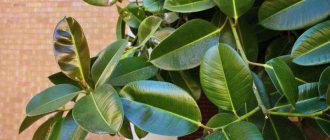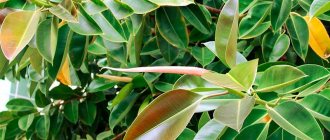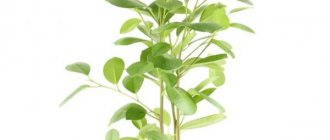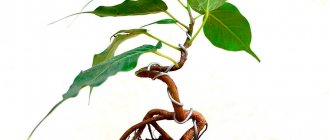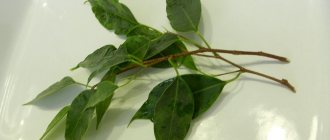Plants » Flowers
1
1451
Article rating
Kira Stoletova
A small plant brought from exotic countries will help to decorate a house or apartment and enliven a boring interior. Few people know, but Ficus Belize owes its origin to distant Africa and countries with a hot climate and sandy soil.
Caring for ficus Belize at home
Planting a shoot of Ficus Belize is not difficult, and the perennial crop does not require a lot of time for care and money for fertilizer. How to care for Ficus?
Description
Ficus Belize is difficult to confuse with similar green plants growing on the south side of a residential building. The dense dark green leaves, which contain poisonous juice, love sunlight and warmth. The stems and shoots of the ficus look unusually juicy. The beautiful play of shades, the unusual shape of the foliage and the elongated stem make the Belize variety not only colorful, but also memorable.
The color of Ficus foliage is always heterogeneous. Green, light green, pale colors, smoothly turning into the stem in the warm season, are crowned with small bright inflorescences.
The Belize variety loves not only high temperatures, but also free space. When breeding at home, it needs to organize special conditions for rapid growth and provide constant feeding, thanks to which the foliage will grow. A culture growing in the wild spaces of African countries needs sun and regular watering. Water and fertilizers, which feed the variety’s root system through the soil, undergo additional preparation. This unpretentious variety requires special care.
Ficus can withstand unfavorable environmental conditions for several weeks, and only prolonged exposure to cold or constant shade leads to its death.
Belize belongs to the Euphorbiaceae family, which grows in hot countries and does not tolerate too low air temperatures. It will be possible to grow the crop in any region if you provide the succulent leaves, stem and root system with constant nutrition and a little warmth.
Care
For some beginners, the ficus trees stretch upward and the purple stem becomes thinner. This phenomenon indicates improper care of exotic crops.
Caring for a Belize ficus does not take much time. A cutting planted in the warm season is quickly accepted and begins to grow.
Belize is planted closer to spring, and in the fall the first inflorescences appear on it. It is important to time planting and plan constant watering. In winter, only the soil requires moisture; it should not dry out.
The content of Ficus includes a number of simple activities:
- regular watering;
- fertilizing the soil and root system (fertilizer is spread 1 cm above ground level);
- ventilation of the room;
- organization of proper lighting and temperature conditions;
- air humidification.
The optimal ambient temperature is between 20°C and 25°C. In winter, the minimum temperature is 16°C. The lower the air temperature, the slower the stem grows. Slowing growth allows the ficus to survive unfavorable environmental conditions.
In summer, the plant can be taken to the balcony, but it is important to protect the foliage from drafts: frequent temperature changes make the crop weak and lethargic. It will be more difficult to restore nutrition to the root system if the soil dries out. With the arrival of autumn, watering must be reduced.
Reproduction
Seed propagation of all types of ficus, including the rubber plant, is difficult. Planting material is difficult to obtain, and the seeds must be fresh.
The leaf quickly gives roots, which is often shown in photos and videos. But it does not contain enough genetic material; it will not be able to grow a stem and become a full-fledged plant. If the plate avoids drying out or rotting, it will live out its allotted years, turn yellow and die.
Ficus Elastica lovers propagate:
- Rooting the apical cuttings remaining after pruning. They are placed in water, planted in perlite, peat with sand or other light substrate. Roots will appear in 3-4 weeks.
- Layering - a semi-lignified node is specially damaged, wrapped in damp sphagnum and cellophane after treatment with a stimulant. When the roots become clearly visible and fill the entire volume, cut off and replant the branch.
- Mass reproduction of Elastica is possible by pieces of stem with one leaf. They are immediately placed in ficus soil with sand or perlite (1:1).
It is considered that rooting has been successful when a new plate appears or the shell that did not have time to open before the operation sheds.
Lighting and Humidity
Before planting a ficus, you should make sure that your home has all the necessary conditions for the plant to grow properly.
The optimal place for planting the crop is a window sill in the southern part of the room. It is necessary to avoid direct sunlight, which causes burns on the foliage of the flower. If there is no other place in the apartment or house, you can make a small shelter for the pot.
Protect the plant from direct sunlight
The more heat there is in the room, the brighter the color and iridescence of the variety will be. Bright light helps the crop begin to grow rapidly. The southeast side of the room can also become a permanent residence for the ficus. In summer, you can water the flowerpot literally every day. In spring, fertilizing the soil with water occurs at least once every 3 days. The soil in the pot should always be soft and saturated with moisture. Only under such conditions can Belize grow not only quickly, but also correctly.
In winter, watering is reduced to 2 times a month. This procedure allows you to preserve the soil until spring. It is necessary to take special care of its saturation, and drain off excess moisture immediately. High air humidity will protect the plant skin from severe drying out. To increase humidity, it is advisable to spray the air once every 2 weeks.
How to propagate ficus correctly
Ficus rubber can be propagated in two ways - by cuttings and by air venting. Propagation using cuttings is a more common method. Petioles are cut 10-15 from the apical semi-lignified stems. The leaves are removed from below, shortened from above and wrapped in a tube.
The cut areas are well washed to remove any secreted juice. The cuttings are placed in a substrate prepared with peat and coarse sand and covered with a transparent cap to create the necessary temperature conditions. It is necessary to ventilate the seedlings every day for 10-15 minutes. When the roots form, after about 30 days, the cuttings are transplanted into a pot with soil mixture for ficus.
You can also root petioles in water with the addition of a root growth accelerator. In this case, the roots will appear after 2-4 weeks.
When propagating with offsets, an incision is made on the woody stem, which is covered with sphagnum moss and wrapped in plastic film. This is done at the end of winter before active growth and development of the plant begins. The moss is constantly kept moist. When roots form, the shoot along with the moss is separated from the stem and planted in the prepared soil mixture.
In the second year after planting, the ficus Belize needs to be replanted. Young plants need to be replanted every year, older flowers - once every 2-3 years, very mature ones should not be replanted at all, it is enough to replace the top layer of soil with fresh, nutritious, porous soil. Transplantation is carried out in spring or early summer. You can add turf soil, leaf humus and sand to the acquired peat soil. For transplantation you need:
- prepare a new pot 2 cm larger than the previous one;
- make sure that there are drainage holes in it;
- remove the plant from the old container along with the earthen lump;
- remove the top layer of the lump a little;
- place the flower along with a lump of earth in a new pot filled with drainage and soil mixture;
- fill the empty cavities with soil, compacting them.
After transplantation, the ficus needs to be provided with proper care. Purchased plants should be replanted only after 2-3 weeks to allow the flower to adapt to new conditions.
Landing
The substance for planting is prepared in advance; it must be provided with a neutral acidic environment. If you plant a crop in ordinary soil, it will soon dry out. Before planting the root system (the rhizome is shaken off the soil from the transport pot), the prepared and enriched soil is loosened. To prepare the soil with your own hands, you will need to mix turf and leaf soil in equal parts. Sand is used to dilute the soil.
Favorable environment for rapid growth of cuttings:
- turf soil;
- leaf soil;
- peat soil;
- sand.
Homemade soil can be additionally fertilized and watered. A special drainage layer is lined at the bottom of the pot, allowing water for irrigation not to stagnate near the rhizome. In such conditions, the ficus will be able to grow, and the green leaves will look fresh all year round. Excessive shade will only harm the plant, which should not be placed in direct sunlight; hiding the crop is also not recommended. Green Ficus may dry out, which indicates improper care.
Fertilizing the soil is needed only in the warm season: spring and autumn. To recharge, you should use mineral fertilizers and organic mixtures that are diluted with water. The main purpose of fertilizers is to increase the level of nitrogen contained in the soil. In winter, you need to wait a while with feeding, because the growth of ficus slows down significantly.
Pruning of the plant occurs from the second year of the variety’s life. Shoots that are too elongated are carefully trimmed. This is done at the end of spring, before active growth begins. Dry foliage or damaged parts of the crop should also be trimmed so that the stem does not lose excess juices.
Diseases and pests
Ficus Belize is not often exposed to diseases and pests, but sometimes, especially with improper care, such troubles can happen. The most common problem is yellowing and falling leaves. The reason for this may be:
- Insufficient moisture or, conversely, waterlogging. The solution to the problem may be to change the watering regime.
- Insufficient lighting. The flower can be moved to a more illuminated place, avoiding direct sunlight. In this case, it is worth remembering that the ficus can also shed its foliage due to a change in location.
- Inappropriate pot size. A mistake is planting a plant in a container that is too large and too small. If this is the reason for the loss of foliage, the flower should be transplanted into a pot of suitable size.
- Root system rotting. This is evidenced by the unpleasant odor emanating from the soil. In this case, it is necessary to clean the roots from the earthen clod, remove all rotten and damaged roots, dry them well and replant them in a new, fresh soil mixture.
- Too much fertilizer, causing leaves to curl. It is necessary to reduce the amount of fertilizing or stop it altogether.
In addition, fungal diseases and insect pests can be the cause of the shedding and yellowing of foliage in the Belize ficus. Among the diseases are the following:
- Anthracnose, when infected, the edges of the foliage become covered with rusty spots and burns. As a result, the leaves fall off. In case of disease, it is necessary to remove all affected parts of the plant and treat it with a fungicide.
- Cercospora. Signs of the disease are barely noticeable black spots on the leaves of the ficus. At the initial stage, the foliage does not suffer much, but as the disease progresses, it begins to turn yellow and fall off. When infected, the diseased areas of the flower are removed and it is treated with a special antifungal agent.
- Another fungal disease that affects ficus is botrytis. The foliage becomes covered with gradually increasing yellow or rusty spots. In case of illness, the plant is freed from infected parts and treated with a fungicide intended to treat fungal diseases.
- Pests. The most common insects that attack ficus are spider mites, mealybugs, and scale insects. They are removed with a cotton swab soaked in alcohol, and the plant is treated with insecticides designed to combat harmful insects.
With proper attention and good care, the Belize ficus will delight you with its variegated tricolor color and healthy appearance for many years.
Ficus propagation / Ficus Belize:
Transplanting and watering
Choosing a pot for planting is a simple matter, but it also requires knowledge about the characteristics of crop growth. The height of the planting container is equal to a third of the height of the entire plant. It is better not to take a pot without a drainage hole, otherwise draining excess water will become a big problem. The material from which the pot is made must have a porous structure. Ceramics are suitable for planting Ficus of any size.
The bottom of the container must be covered with a drainage layer. Pebbles and small pebbles will allow water to pass through the drainage hole without harming the root system. Expanded clay is also suitable for drainage. To further protect the rhizome, a layer of fine-grained sand is laid over the pebbles, then soil is poured around the root system and carefully compacted. For a tall plant, during planting, a strong support is installed so that the ficus is not in danger of being destroyed. The first watering occurs on the second day after planting, when the rhizome is compacted.
How to choose and how much it costs
It is better to buy ficus in the spring. During the spring-summer season, the indoor plant will go through an adaptation period, increase its green mass and gradually enter the dormant stage.
When purchasing, you should pay attention to appearance. In a healthy specimen:
- dense foliage without signs of wilting;
- the color is bright, there are no spots;
- the root system has no damage, mold or rotten fragments.
A newly purchased flower is not replanted immediately, but is given time to adapt to the changed conditions - at least 2 weeks. The exception is when the plant is planted in a cramped pot or depleted soil.
The average price of an indoor ficus up to 0.5 m high is about 500 rubles.
